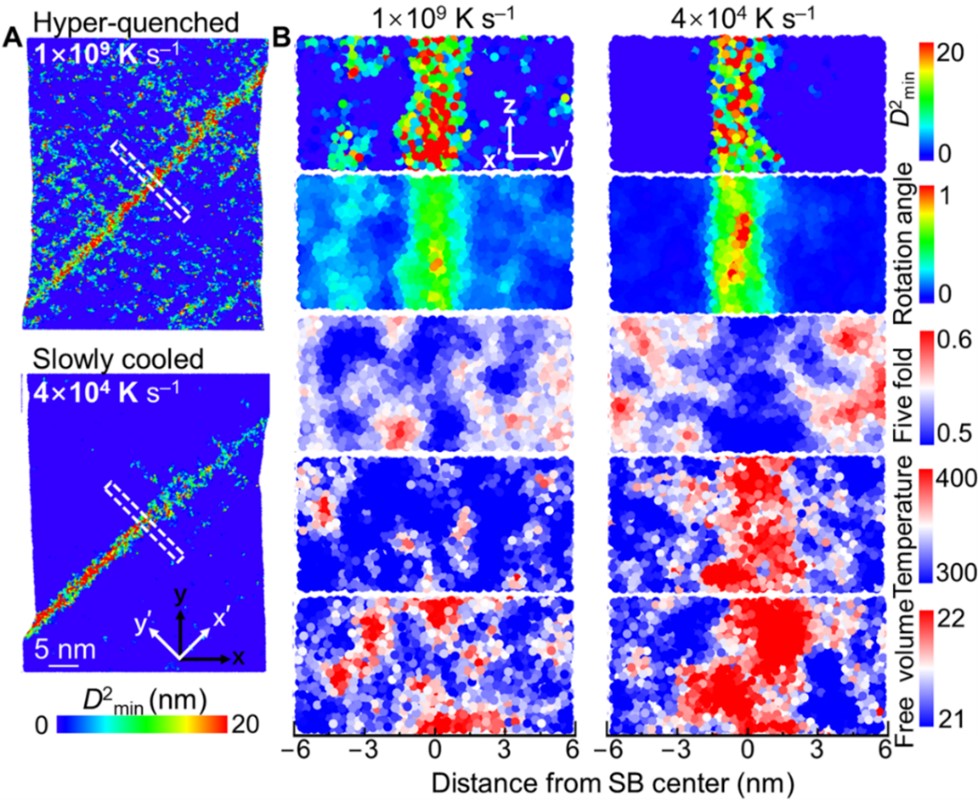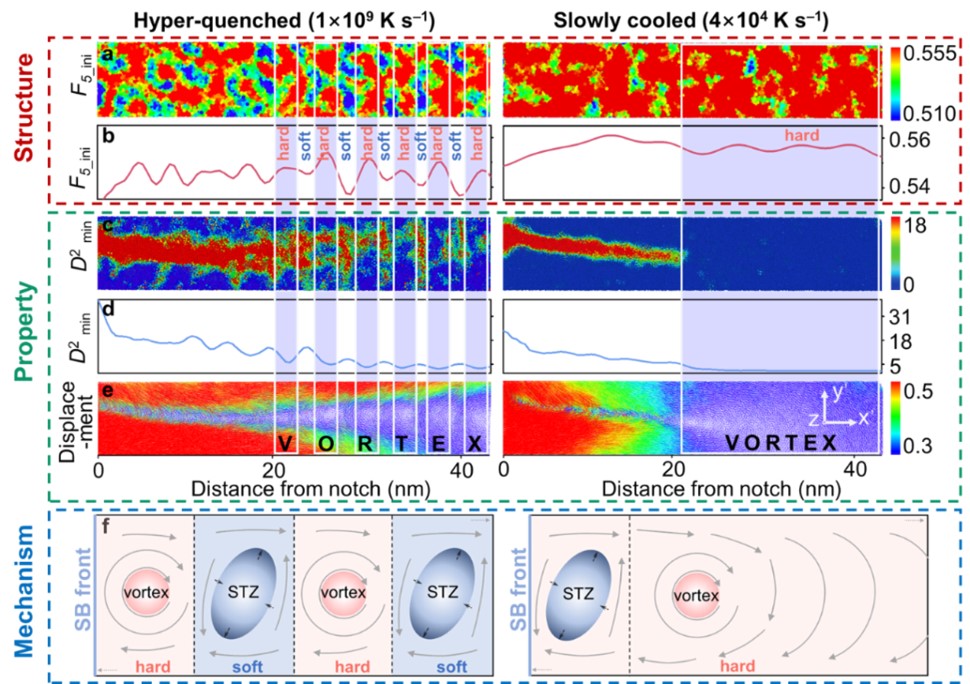Metallic glasses, also known as amorphous alloys, exhibit superior mechanical properties such as high strength and elasticity due to their disordered atomic arrangement. However, these properties also render them prone to the formation of localized shear bands at the nanoscale during plastic deformation. The initiation and propagation of these shear bands often trigger brittle fracture, which severely limits the application of metallic glasses in engineering fields. The process of shear band formation and evolution is a complex, multi-scale phenomenon that involves intricate coupling between atomic-scale and macroscopic behaviors. Due to the rapid timescales (on the order of microseconds) involved, traditional experimental techniques are unable to directly observe the atomic mechanisms. Moreover, conventional molecular dynamics (MD) simulations typically employ cooling rates much higher than those used in experiments (greater than 10¹⁰ K/s), resulting in structural states that diverge significantly from those of real materials, thus hindering the accurate reproduction of shear deformation mechanisms. Therefore, revealing the microscopic mechanisms behind the initiation and propagation of shear bands has become a critical frontier in condensed matter physics, material mechanics, and computational materials science.
In response to this scientific challenge, Prof. Ding Jun and Prof. Ma En, leading a research team at the Center for Materials Innovation and Design (CAID) at Xi'an Jiaotong University’s State-Key Laboratory for Mechanical Behavior of Materials (SKL-MBM), have successfully studied the structural evolution and shear band deformation behavior of Mg₆₅Cu₂₅Y₁₀ amorphous alloy. This study was conducted across a wide range of cooling rates, spanning nine orders of magnitude (from 10⁴ K/s, comparable to experimental casting conditions, to the typical MD simulation rates of 10¹³ K/s). The team used an efficient molecular dynamics–Monte Carlo coupling simulation method developed in their previous work (PNAS, 119 (2022) e2213941119) to simulate a cooling rate closer to actual experimental conditions. The results show that, compared to ultrafast cooled samples, the properties of shear bands in slowly cooled samples significantly change (either increasing or decreasing) (Figure 1). Further analysis revealed that the evolution of the structural state leads to a qualitative change in the shear band extension mechanism. In ultrafast cooled samples, shear band propagation is intermittent, with sequential activation and merging of multiple shear deformation zones, separated by vortex fields. In contrast, slowly cooled samples exhibit continuous and rapid shear band propagation, mediated by local shear softening and the formation of large vortex fields, with a stronger collective structural response. This mechanism shift arises from significant differences in the number density and spatial distribution of activated shear deformation zones in different structural states (Figure 2).
This study provides the first atomic-level insight into the decisive role of structural state in the propagation mechanism of shear bands. These findings offer new perspectives on the microscopic dynamics behind the initial formation and propagation of shear bands in amorphous alloys, highlighting the potential for controlling shear band behavior by tuning the structural state of metallic glasses. This research opens new avenues for optimizing the mechanical properties of amorphous alloys to meet specific engineering application requirements.

Figure 1. Microscopic properties of shear bands in Mg₆₅Cu₂₅Y₁₀ amorphous samples with ultrafast quenching and slow cooling.

Figure 2. Atomic-level mechanisms when the shear band front propagates to the sample’s center.
Recently, these research findings were published in the Proceedings of the National Academy of Sciences of the United States of America (PNAS) under the title "Structural State Governs the Mechanism of Shear-Band Propagation in Metallic Glasses." The paper was co-authored by PhD student Yu Jinhua as the first author, with Professors Ding Jun and Evan Ma serving as the corresponding authors. This work was funded by the National Natural Science Foundation of China, State Key Laboratory for Advanced Metals and Materials (2024-Z15), National Youth Talents Program and the HPC platform of Xi’an Jiaotong University.
Link to the paper: https://www.pnas.org/doi/10.1073/pnas.2427082122
Professor Ding Jun’s Research Homepage: https://gr.xjtu.edu.cn/en/web/dingsn/home


